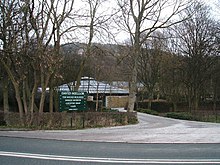David Mellor (designer)
David Mellor | |
|---|---|
 The former Hathersage gas works which was converted into the David Mellor cutlery factory | |
| Born | David Rogerson Mellor 5 October 1930 |
| Died | 7 May 2009 (age 78) |
| Occupation | Designer |
| Known for | Design for bus shelters, cutlery, and the traffic lights system |
| Spouse | Fiona MacCarthy |
| Children | 2 |
David Rogerson Mellor
Regarded as one of the best-known designers in Britain,
Early life and training
Mellor was born in Ecclesall, Sheffield, where his father was a toolmaker for the Sheffield Twist Drill Company. From the age of eleven, Mellor attended the Junior Art Department of Sheffield College of Art, receiving an intensive training in craft skills. He made his first piece of metalwork – a sweet dish – at this early age.
He studied at the Royal College of Art in London from 1950. Mellor's first cutlery, "Pride", designed while he was still a student, is still in production. Mellor also studied at the British School at Rome.
Silversmithing
Returning to Sheffield, Mellor set up a
Industrial design
Alongside silversmithing, Mellor was stimulated by the relatively new design potential of stainless steel. His "Symbol" cutlery, manufactured from 1963 at Walker & Hall's purpose-built modern factory at Bolsover in Derbyshire, was the first high-quality stainless steel cutlery to be produced in quantity in the UK. Mellor was subsequently commissioned by the government to redesign standard issue cutlery for canteens, hospitals, prisons and the railways, reducing the traditional 11-piece place set to five pieces and thereby reducing costs.

Mellor worked for the
Manufacturing
In 1973 Mellor made the decision to begin manufacturing his own cutlery designs. To house his factory he renovated a large historic mansion, Broom Hall, in central Sheffield. The building was then derelict. The machines were moved into the extensive Georgian wing. The conversion of the building received a European Architectural Heritage Award. As well as introducing new concepts in cutlery he rethought the traditional methods of production. Workers in the Sheffield cutlery industry had up to then specialised in a single operation, but he introduced a new system whereby his cutlery makers rotate from task to task, increasing job satisfaction through a sense of involvement in the project.
In 1990, Mellor finally realised a long-held ambition by commissioning a new purpose-built cutlery factory designed by
Retailing
The first David Mellor shop opened at 4 Sloane Square, London, in 1969. It was followed by shops in James Street, Covent Garden; King Street, Manchester; and 22 Shad Thames, Butlers Wharf, London (since closed). A shop and a design museum was opened in Hathersage, alongside the Round Building factory in 2006.[5]
Public work and honours
Mellor was the youngest
A large-scale retrospective exhibition "David Mellor Master Metalworker" was held at the Design Museum, London, in 1996. There is a David Mellor Design Museum in a building alongside the cutlery factory at Hathersage..
Personal life
Mellor retired from designing in 2005 at the age of 74. Mellor was married to Fiona MacCarthy, a biographer and cultural historian. They have two children, Corin (born 1966), product and interior designer, who is Creative Director of David Mellor Design; and Clare, a graphic designer with her own London practice. Mellor died on 7 May 2009 at the age of 78. His wife died in 2020.
References
- ^ "Tribute to alumnus David Mellor, Sheffield's master metalworker" (PDF). Sheffield Hallam University. Retrieved 14 June 2014.
- ^ "David Mellor: designer, manufacturer and retailer", The Times, 7 May 2009
- ^ "David Mellor Cutlery Designer + Manufacturer (1930–2009)". Design Museum. Retrieved 14 June 2014.
- ^ Sheffield's man of steel Renowned cutler David Mellor, who has always lived and worked in Sheffield, displays unwavering commitment to good design, 22 October 1998, Kenneth Powell, Architects Journal. Retrieved 13 August 2008
- ^ https://www.davidmellordesign.com/david-mellor-short-chronology/
Further reading
- Mellor, David (1998). Master Metalworker. Sheffield Galleries and Museums Trust.
- Bayley, Stephen; Conran, Terence (2007). Design: Intelligence made Visible. Conran Octopus.
- Hollweg, Lucas (8 February 1997). "Genius of the knife, fork and spoon". Daily Telegraph.
- Lawrence, Felicity (19 July 1997). "Man of steel". Guardian Weekend.
- Niesewand, Nomie (25 September 1998). "Fifty years at the cutting edge". The Independent.
- Rattray, Fiona (2 April 2005). "Legends of British Design". The Independent Magazine.
- Powell, Kenneth (22 October 1998). "Sheffield's man of steel". Architects' Journal.
External links
- http://news.bbc.co.uk/local/sheffield/hi/people_and_places/arts_and_culture/newsid_8283000/8283700.stm
- http://news.bbc.co.uk/local/sheffield/hi/people_and_places/arts_and_culture/newsid_8283000/8283568.stm
- David Mellor Design
- David Mellor – Daily Telegraph obituary
- Obituary in The Guardian
- Obituary in The Independent
